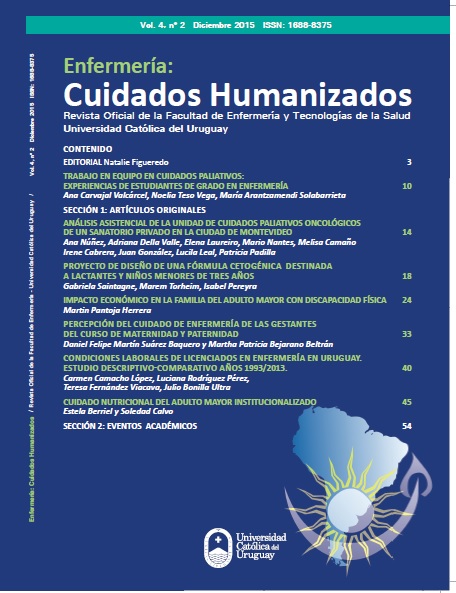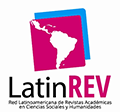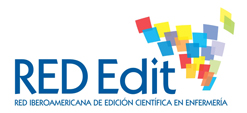ECONOMICAL IMPACT TO THE FAMILY WITH ELDERS PHYSICALLY DISABLED
DOI:
https://doi.org/10.22235/ech.v4i2.887Keywords:
Elderly, Family, Economical Development, Disabled.Abstract
The following research is a descriptive, observational, crosssectional study, where the economic impact on the family caring for an elder with a disability was studied. The families with elder adults hospitalized at the National Rehabilitation Institute (INR) with some type of physical disability were chosen. The following scales were applied: Family-social Assessment, Barthel Index and a modified questionnaire taken from the National Institute of Statistics and Geography (INEGI). The objectives were to determine the economic impact on the family caring for elder adults with a disability; to analyze income, physical and psychological conditions; and to identify the coverage that exists in health and pension plans. It was found that this population of study, females predominated (67.47%). 38.6% of the patients were between 71 and 80 years old. 99.4% of them had a physical disability. With regards to marital status, 45.2% were married and only 0.6% divorced; and it was observed that 56% of the population had a college degree. 61.4% of elder adults live with their family, and 21.7% of them pay rent. It is alarming to realize that 16.3% of them work, 7.8% are pensioners, 5.4% are retired and only one elderly patient (0.6%) was looking for employment. However, having an elder hospitalized with a disability significantly impacts on the family economy. The revenue needed to ensure a good quality of life in old age depends on factors such as age, health status, living arrangements and previous consumption patterns.
Downloads
References
(1) Aparicio R. Transición demográfica y vulnerabilidad durante la vejez. [Internet]. 2002 [citado 01 Jun 2013]; p.155-168. Disponible en: http://envejecimiento.sociales.unam.mx/archivos/mexico.pdf.
(2) L ópez Doblas J, Díaz Conde MP. Aspectos sociológicos del envejecimiento. Portal Mayores, nº 73. Lecciones de Gerontología, XIV [Internet]. 2007 [citado 05 Oct 2013]. Disponible en: http://www.envejecimiento.csic.es/documentos/.../lopez-aspectos-01.rtf
(3) Lwanga SK, Lemeshow S. Sample size determination in health studies. A practical manual. Geneva: World Health Organization[Internet] 2013 Nov 2013 [citado 10 Oct 2014]. Disponible en: http://www.tbrieder.org/publications/books_english/lemeshow_samplesize.pdf
(4) Morales I, Villalón J. Chile y los adultos mayores: impacto en la sociedad del 2000. Santiago de Chile: Departamento Estadísticas Demográficas y Sociales; 1999. [Internet]. [citado 01 Sep 2013]. Disponible en: http://www.ine.cl/canales/chile_estadistico/estadisticas_sociales_culturales/adultosmayores/pdf/mayor2000.pdf
(5) Ocampo Chacón RA. Vejez y discapacidad: visión comparativa
de la población adulta mayor rural. Valle Central de Costa Rica; 2004. [Internet]. [citado 01 Nov 2013].Disponible en: http://ccp.ucr.ac.cr/bvp/pdf/tfgs2004/tfg_rocampo.pdf
(6) O sorio Rodríguez A, Álvarez Mora A. Introducción a la Salud Familiar. 1a ed. San José: CENDEISSS; 2004.
(7) Consejo Nacional de Población y Secretaria de Gobernación.
Encuesta Nacional de la Dinámica Demográfica; 2013. [Internet]. [citado 15 Ago 2013. Disponible en: www.conapo.gob.mx/es/CONAPO.
(8) Banco de México. Diario Oficial de la Federación Documento Metodológico INPC; 2011. [Internet]. [citado Sep 2013]. Disponible en: http://www.banxico.org.mx/politica-monetaria-e-inflacion/material-de-referencia/intermedio/inflacion/elaboracion-inpc/%7B50ECE064-0F0AF533-1477-3C77A959CE7B%7D.pdf
(9) Cámara de Diputados del Honorable Congreso de la Unión. Diario Oficial de la Federación .Ley de los Derechos de las Personas Adultas Mayores [Internet]. 2012 [citado 25 Abr 2012].Disponible en: http://www.diputados.gob.mx/LeyesBiblio/pdf/245.pdf
(10) Consejo Nacional de Población. Diagnóstico socio-demográfico
del envejecimiento en México. Serie de Documentos Técnicos. [Internet]. 2011 [citado 01 Sept 2013]. Disponible en: http://www.unfpa.org.mx/publicaciones/Envejecimiento_F_14oct11.pdf
(11) Instituto Nacional de Estadística y Geografía. Encuesta Nacional de Ingresos y Gastos de los Hogares 2010. [Internet]. 2011 [citado 01 Sep 2013]. Disponible en: http://www.inegi.org.mx/est/contenidos/espanol/metodologias/
encuestas/hogares/enigh10_adiciones.pdf
(12) Instituto Nacional de las Personas Adultas Mayores. Modelos de Atención Gerontológica. [Internet] 2010 [citado 01 Sep 2013. Disponible en: http://www.inapam.gob.mx/work/models/INAPAM/Resource/Documentos_Inicio/Libro_Modelos_de_Atencion_Gerontologica_(web).pdf
(13) Fondo Nacional de la Discapacidad de Santiago de Chile. Primer Estudio Nacional de la Discapacidad en Chile. [Internet]. 2005 [citado 15 Ene 2014]. Disponible en: http://www.ine.cl/canales/chile_estadistico/encuestas_discapacidad/
pdf/presentacion.pdf
(14) Organización Iberoamericana de Seguridad Social y Secretaría
de Estado de Servicios Sociales, Familias y Discapacidad. Ministerio de Trabajo y Asuntos Sociales de España. Situaciones, necesidades y demandas de las personas mayores en los países del Cono Sur. Proyecto sobre Personas Mayores, Dependencia y Servicios Sociales en
los países del Cono Sur. Apuntes para un diagnóstico [Internet].
[citado 14 Ene 2014]. Disponible en: http://envejecimiento.csic.es/documentos/documentos/oisssituacion-
(15) Organización Mundial de la Salud. [Internet]. [citado 01 Jul 2013]. Disponible en: http://www.who.int/es/
Downloads
Published
How to Cite
Issue
Section
License
Copyright (c) 2015 Enfermería: Cuidados Humanizados

This work is licensed under a Creative Commons Attribution 4.0 International License.

















